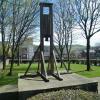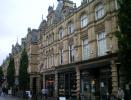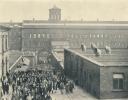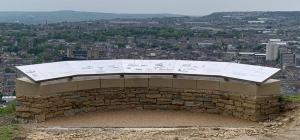The Halifax Gibbet
A forerunner of the Guillotine

The Halifax Gibbet was an early guillotine . Estimated to have been installed during the 16th century, it was used as an alternative to beheading by axe or sword. Halifax was part of the Manor of Wakefield, where ancient custom and law gave the Lord of the Manor the authority to execute summarily by decapitation any thief caught with stolen goods to the value of 131⁄2d or more (equivalent to £8 in 2021), or who confessed to having stolen goods of at least that value. Decapitation was a fairly common method of execution in England, but Halifax was unusual in two respects: it employed a guillotine-like machine that appears to have been unique in the country, and it continued to decapitate petty criminals until the mid-17th century.
The device consisted of an axe head fitted to the base of a heavy wooden block that ran in grooves between two 15-foot-tall (4.6 m) uprights, mounted on a stone base about 4 feet (1.2 m) high. A rope attached to the block ran over a pulley, allowing it to be raised, after which the rope was secured by attaching it to a pin in the base. The block carrying the axe was then released either by withdrawing the pin or by cutting the rope once the prisoner was in place.
Almost 100 people were beheaded in Halifax between the first recorded execution in 1286 and the last in 1650, but as the date of the gibbet's installation is uncertain, it cannot be determined with any accuracy how many individuals died via the Halifax Gibbet. By 1650, public opinion considered beheading to be an excessively severe punishment for petty theft; use of the gibbet was forbidden by Oliver Cromwell, Lord Protector of the Commonwealth of England, and the structure was dismantled. The stone base was rediscovered and preserved in about 1840, and a non-working replica was erected on the site in 1974. The names of 52 people known to have been beheaded by the device are listed on a nearby plaque.
“If a felon be taken within their liberty or precincts of the said forest [the Forest of Hardwick], either handhabend [caught with the stolen goods in his hand or in the act of stealing], backberand [caught carrying stolen goods on his back], or confessand [having confessed to the crime] cloth or any other commodity to the value of 13½d, that they shall after three market days or meeting days within the town of Halifax after such his apprehension, and being condemned he shall be taken to the gibbet and there have his head cut off from his body.”
Suspected thieves were detained in the custody of the lord of the manor's bailiff, who would summon a jury of 16 local men "out of the most wealthy and best reputed", four each from four local townships. The jury had only two questions to decide on: were the stolen goods found in the possession of the accused, and were they worth at least 131⁄2d. The jury, the accused, and those claiming that their property had been stolen, were brought together in a room at the bailiff's house. No oaths were administered and there was no judge or defence counsel present; each side presented their case, and the jury decided on guilt or innocence.
The law was applied so strictly that anyone who apprehended a thief with his property was not allowed to recover it unless the miscreant and the stolen goods were presented to the bailiff. The goods were otherwise forfeited to the lord of the manor, and their previous rightful owner was liable to find himself charged with theftbote, or conniving in the felony. Halifax's reputation for strict law enforcement was noted by the antiquary William Camden and by the "Water Poet" John Taylor, who penned the Beggar's Litany: "From Hell, Hull, and Halifax, Good Lord, deliver us!"
Before his execution a convicted felon was usually detained in custody for three market days, on each of which he was publicly displayed in the stocks, accompanied by the stolen goods. After the sentence had been carried out a county coroner would visit Halifax and convene a jury of 12 men, sometimes the same individuals who had found the felon guilty, and ask them to give an account under oath of the circumstances of the conviction and execution, for the official records.
The Halifax Gibbet was dismantled after the last executions in 1650, and the site was neglected until the platform on which the gibbet had been mounted was rediscovered in about 1840. A full-size non-working replica was erected on the original stone base in August 1974; it includes a blade made from a casting of the original, which is displayed in the Bankfield Museum in Boothtown on the outskirts of Halifax. A commemorative plaque nearby lists the names of the 52 people known to have been executed by the device.
Such is the fascination with this method of execution that there is far more information than can be easily reproduced here. We are grateful to Wikipedia, Calderdale Council and the My learning website. Please visit their websites for a more comprehensive description.
Calderdale website https://www.visitcalderdale.com/see-and-do/attractions/halifax-gibbet/
My learning website https://www.mylearning.org/stories/crime-and-punishment-the-halifax-gibbet/1311
Related pages...
Calderdale Royal Hospital
more The main Hospital for the the town
Shaw Lodge Mills
more A brief history of this icon of the textile industry in the Halifax area

The Shay Stadium
more The home of professional sport in the town

Eureka! The National Children's Museum
more A popular children's museum
The Halifax Building Society
more Headquarters of the eponymous financial institute
_1.jpg)
Wainhouse Tower
more A victorian "Folly"

Stoodley Pike
more A war memorial in the Todmorden area

The Halifax Borough market
more The victorian covered market in the town centre
_1.jpg)
Square Church Spire
more The spire is all that remains of this church
_1.jpg)
The Piece Hall
more Halifax's jewel in the crown
Halifax Town Hall
more Seat of Local Governance

Halifax Minster
more The centre of worship in Town

Dean Clough
more An industrial powerhouse of the past
_1.jpg)
All Souls Church
more The church of a former model village

Black Dyke Mills
more An icon on the outskirts of Halifax
back to page above this...

The Centenary Viewing Platform at Beacon Hill
back To celebrate 100 years of service to the town of Halifax we have commissioned viewing platform on Beacon Hill overlooking the town. Situated on the Magna Via, an old packhorse route, the walk to the top is worth it.